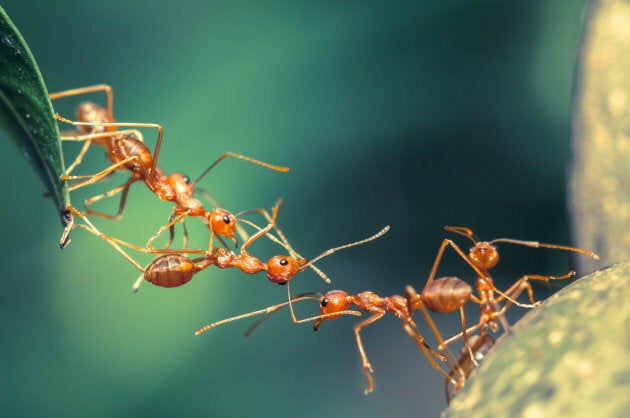Ants are smarter than you think. But do they have some sort of sixth sense that told them the NSW and Queensland floods were coming?
The image above suggests they did. It was posted on Twitter on Wednesday by Brian Dodd, who lives in the foothills of the Gibraltar Range in northern NSW, and whose property received a whopping 340mm of rain.
The Huffington Post Australia contacted Dodd, who confirmed that the mounds were constructed just before the heavy rain. What can we infer from this? Can ants read weather forecasts?
We wanted Antswers, so we contacted Dr Kirsti Abbott of the University of New England. She runs a thing called The School of Ants and gives TED Talks about ants while wearing t-shirts with ant motifs.
So Dr Abbott, what's the deal? Can ants tell that bad weather is coming?
"We've woven a pretty watertight story about how ants can predict the weather, but you might be surprised to know there's very little research and hardly any empirical evidence about how ants suddenly change their behaviour suddenly in response to the weather," Abbott says in the above video.
She confirmed that point in conversation with us, further explaining how little serious research has been done into the preparations (if any) which ants do before storms.
But she did explain that ants breathe through tiny holes in their exoskeleton called spiracles, and that they may detect changes in atmospheric pressure this way. (Typically air pressure drops when it rains heavily, which would act as a warning to ants.)
"A combination of pressure, humidity and day length causes ants to respond by changing their nest structure and their behaviour in some way," Abbott explained. "For example they'll move inside."

While ants' predictive behaviour patterns before storms are still up for serious discussion, there's no dispute that they change their nests AFTER rain.
"Following rain absolutely, they've got to clean up and re-dig tunnels, which is a bit of a no-brainer," Abbott said. "You'd do that too if your house was destroyed."
Indeed.
Before we let Dr Abbott go, we asked her to share a favourite fact or two about the insects which, in the video above, she calls "the little things running the world from the ground up". (Eek!)

"All the worker ants you see on the ground are female," she said.
Really?
"Yes. Males are only produced a few times a year. They're completely redundant in the social structure.
"One of the things I'm always doing is modifying people's language. When they talk about squashing ants, people often say 'don't kill him'. I have to tell them they should be saying 'don't kill her'."
Good point. For the record, scientists have identified 13,000 species of ants in the world, but the real number is probably double that. One species, the fire ant, has a novel way of surviving floods.
And now, for those over 40 with good memories and an appreciation of fine British humour, and especially for you Dr Kirsti Abbott, here's a funny dialogue about ants going to discos.
ALSO ON HUFFPOST AUSTRALIA